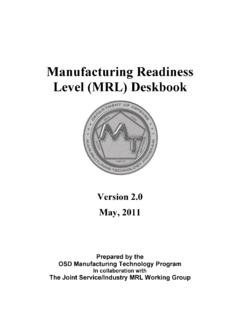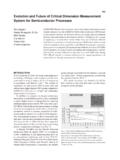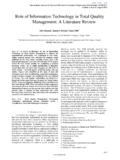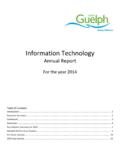Transcription of Measuring Productivity - OECD Manual
1 STATISTICS ISBN 92-64-18737-592 2001 12 1 :HSTCQE=V]\X\Z: Measuring Productivity OECD Manual measurement of Aggregate and Industry-levelProductivity GrowthMeasures of Productivity growth constitute core indicators for the analysis of economicgrowth. However, there are many different approaches to Productivity measurement andtheir calculation and interpretation requires careful consideration, in particular whenundertaking international comparisons. The Measuring Productivity OECD Manualis thefirst comprehensive guide to the various Productivity measures aimed at statisticians,researchers and analysts involved in constructing industry-level Productivity Manual presents the theoretical foundations to Productivity measurement , and discusses implementation and measurement issues.
2 The text is accompanied by empirical examples from OECD countries and by numerical examples to enhance its readability. The Manual also offers a brief discussion of the interpretation and use of Productivity measures. Related Publication This Manual provides a link with Measuring Capital OECD Productivity OECD ManualMeasuring ProductivityOECD ManualMEASUREMENT OF AGGREGATE AND INDUSTRY-LEVEL Productivity GROWTHAll OECD books and periodicals are now available on FOR ECONOMIC CO-OPERATION AND DEVELOPMENTM easuring ProductivityMEASUREMENT OF AGGREGATE AND INDUSTRY-LEVEL Productivity GROWTHOECD ManualORGANISATION FOR ECONOMIC CO-OPERATION AND DEVELOPMENT Pursuant to Article 1 of the Convention signed in Paris on 14th December 1960, and which came intoforce on 30th September 1961, the Organisation for Economic Co-operation and Development (OECD)
3 Shall promote policies designed: to achieve the highest sustainable economic growth and employment and a rising standard ofliving in Member countries, while maintaining financial stability, and thus to contribute to thedevelopment of the world economy; to contribute to sound economic expansion in Member as well as non-member countries in theprocess of economic development; and to contribute to the expansion of world trade on a multilateral, non-discriminatory basis inaccordance with international obligations. The original Member countries of the OECD are Austria, Belgium, Canada, Denmark, France,Germany, Greece, Iceland, Ireland, Italy, Luxembourg, the Netherlands, Norway, Portugal, Spain,Sweden, Switzerland, Turkey, the United Kingdom and the United States.
4 The following countriesbecame Members subsequently through accession at the dates indicated hereafter: Japan(28th April 1964), Finland (28th January 1969), Australia (7th June 1971), New Zealand (29th May 1973),Mexico (18th May 1994), the Czech Republic (21st December 1995), Hungary (7th May 1996), Poland(22nd November 1996), Korea (12th December 1996) and the Slovak Republic (14th December 2000). TheCommission of the European Communities takes part in the work of the OECD (Article 13 of the OECDC onvention).Publi en fran ais sous le titre :MESURER LA PRODUCTIVIT Mesurer la croissance de la productivit par secteur et pour l ensemble de l conomie OECD 2001 Permission to reproduce a portion of this work for non-commercial purposes or classroom use should be obtainedthrough the Centre fran ais d exploitation du droit de copie (CFC), 20, rue des Grands-Augustins, 75006 Paris,France, tel.
5 (33-1) 44 07 47 70, fax (33-1) 46 34 67 19, for every country except the United States. In the United Statespermission should be obtained through the Copyright Clearance Center, Customer Service, (508)750-8400,222 Rosewood Drive, Danvers, MA 01923 USA, or CCC Online: All other applications forpermission to reproduce or translate all or part of this book should be made to OECD Publications, 2, rue Andr -Pascal,75775 Paris Cedex 16, of Productivity growth constitute core indicators for the analysis of economic , there are many different approaches to Productivity measurement and their calculation andinterpretation requires careful consideration, in particular when undertaking international OECD Productivity Manual is the first comprehensive guide to the various Productivity measuresaimed at statisticians.
6 Researchers and analysts involved in constructing industry-level Manual presents the theoretical foundations to Productivity measurement , and discussesimplementation and measurement issues. The text is accompanied by empirical examples from OECD countries and by numerical examples to enhance its readability. The Manual also offers a briefdiscussion of the interpretation and use of Productivity Manual is a joint product between the OECD Directorate for Science, Technology andIndustry and the OECD Statistics Directorate. It has been authored by Paul Schreyer to whomcomments and questions should be addressed.
7 However, the Manual would not have been possiblewithout the active advice and review process of the Statistical Working Party of the OECD IndustryCommittee and an informal expert group (see Annex 7 for list of participants), both chaired byEdwin Dean (formerly of the United States Bureau of Labor Statistics). The report is published on theresponsibility of the Secretary-General of the Giovannini Risaburo NezuChief Statistician, OECD Director, OECD Directorate for Science, Technology and Industry5 TABLE OF CONTENTS1. INTRODUCTION .. AND STRUCTURE OF THE 72. OVERVIEW OF Productivity OF Productivity TYPES OF Productivity SHORT GUIDE TO SOME Productivity ACCOUNTING AND MAIN ASSUMPTIONS UNDERLYING THE CONCEPTUAL and interpretation of Productivity for OUTPUT.
8 AND VALUE-ADDED BASED .. functions, gross output and value flows of products .. MEASURES OF of value need for independent change and new products .. SOURCES AND STATISTICAL 374. LABOUR OF HOURS COMPENSATION AND LABOUR FOR DIFFERENT TYPES OF LABOUR 465. CAPITAL OF THE PRODUCTIVE STOCK AND OF CAPITAL OF USER profiles, net stock and depreciation .. rate of return and capital ACROSS OF CAPITAL 756. INTERMEDIATE INPUT AND VALUATION .. INDEX NUMBERS .. AND DIRECT OF INDEX NUMBER DIGRESSION: FROM MALMQUIST TO T 898. AGGREGATING Productivity GROWTH ACROSS INDUSTRIES.
9 , AGGREGATION AND INTERMEDIATE WEIGHTS: AGGREGATION OF KLEMS AVERAGES: AGGREGATION OF VALUE-ADDED BASED 989. IMPLEMENTATION GUIDE .. 10110. INTERPRETATION OF Productivity MEASURES .. AND Productivity MEASURES: SOME GROWTH AS COST MEASURES OVER THE BUSINESS AND FIRM-LEVEL Productivity AND Productivity 120 Annex 1 123 Annex 2 Links and References to National Productivity Statistics .. 126 Annex 3 Productivity measurement in a Growth Accounting Framework .. 128 Annex 4 Capital Stock Measures .. 132 Annex 5 User 134 Annex 6 Aggregation of Output, Inputs and 138 Annex 7 Acknowledgements .. 146 REFERENCES AND BIBLIOGRAPHY.
10 147 BoxesBOX 1. THE ECONOMETRIC APPROACH TO Productivity 19 BOX 2. HEDONIC PRICE 36 BOX 3. QUALITY ADJUSTMENT OF LABOUR INPUT IN 49 BOX 4. CAPITAL MEASURES IN THE UNITED 58 BOX 5. CAPITAL MEASURES IN 59 BOX 6. CAPITAL MEASURES IN 60 BOX 7. CHAIN AND FIXED-WEIGHT INDEX NUMBERS IN NATIONAL 86 BOX 8. SUPERLATIVE INDICES OF INPUTS AND 8871. main objectives of this Manual are to: Provide an accessible guide to Productivity measurement for those involved in constructingand interpreting Productivity measures, in particular statistical offices, other relevantgovernment agencies and Productivity researchers. Improve international harmonisation: although there is no strong prescriptive element in themanual, it contains indications about desirable properties of Productivity measures.


















